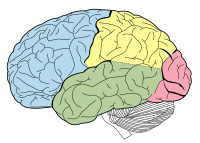
Photo from wikipedia
Brain neural activity decoding is an important branch of neuroscience research and a key technology for the brain–computer interface (BCI). Researchers initially developed simple linear models and machine learning algorithms… Click to show full abstract
Brain neural activity decoding is an important branch of neuroscience research and a key technology for the brain–computer interface (BCI). Researchers initially developed simple linear models and machine learning algorithms to classify and recognize brain activities. With the great success of deep learning on image recognition and generation, deep neural networks (DNN) have been engaged in reconstructing visual stimuli from human brain activity via functional magnetic resonance imaging (fMRI). In this paper, we reviewed the brain activity decoding models based on machine learning and deep learning algorithms. Specifically, we focused on current brain activity decoding models with high attention: variational auto-encoder (VAE), generative confrontation network (GAN), and the graph convolutional network (GCN). Furthermore, brain neural-activity-decoding-enabled fMRI-based BCI applications in mental and psychological disease treatment are presented to illustrate the positive correlation between brain decoding and BCI. Finally, existing challenges and future research directions are addressed.
Journal Title: Brain Sciences
Year Published: 2022
Link to full text (if available)
Share on Social Media: Sign Up to like & get
recommendations!